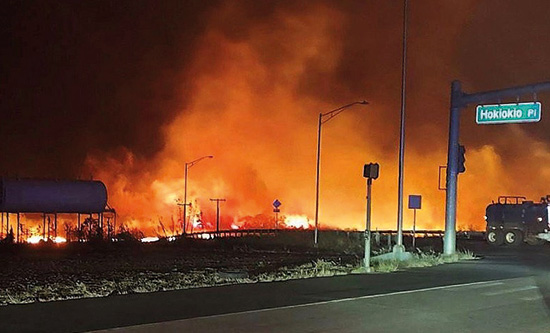
On 8 and 9 August wildfires on the Hawaiʻian island of Maui raged through the historic town of Lāhainā, destroying 2,200 buildings. It left at least 115 dead and over 1,000 people missing: it was the deadliest wildfire disaster on US territory for over a century. The scene after the fire resembled ‘the pictures from Dresden from World War II’ after British and US bombers had completely destroyed that city, according to a Hawaiʻian Emergency Management Agency spokesperson.
Before the fire, the National Weather Service had issued multiple warnings about the risk of wildfires due to strong winds and drought conditions over all the islands of Hawaiʻi. Despite this, the private utility company Hawaiʻian Electric (2022 profits: $241m) wouldn’t turn off the power, as it would ‘inconvenience’ tourists. Inevitably, downed power lines caused sparks, igniting the dry non-native grasses; strong winds caused the fires to spread rapidly. Hawaiʻian and Federal government officials were fully aware that the prevention and response programmes were totally inadequate, but had refused to increase funding. Hawaiʻi has sophisticated siren systems to alert the population to potential disaster like hurricanes and tsunamis, but these were not used on the basis it would cause ‘confusion’. This left residents and workers in Lāhainā with no warnings of the fires and no help in escaping the inferno. When people tried to escape by road some were blocked in by fallen trees and utility poles; others fled into the ocean, waiting hours to be rescued.
The response of the federal government has been shameful, demonstrating total contempt for indigenous and working class people. US President Biden answered ‘no comment’ when asked by reporters about the fires whilst relaxing at his vacation house in Delaware. The US government has offered one-off payments of $700 per household: the total cost of disaster relief at $38m is a miniscule fraction of the $24bn President Biden has recently asked Congress for to aid its proxy war with Russia. The state of Hawaiʻi has the highest cost of living of any US state, mostly exacerbated by the number of billionaires and millionaires buying huge tracts of land for holiday mansions, plus the influx of rich tourists.
In Maui, 52% of the population are classified as ‘working poor’. The Washington Post reported that weeks after the blaze many people were still living in their cars, in tents on the beach, at churches or golf clubs. Most are having to survive on charity, some of it handed out with much fanfare by billionaires with properties on the islands. Meanwhile, the government was quick to reassure tourists that it was still safe to come to the island. With no assistance offered by the state or federal governments to rebuild the ancestral homes and community of the indigenous population, this has paved the way for vulture capitalists to offer to buy up those homes to make fortunes on this prime location. As with all capitalist ventures, the goal is to generate the highest rate of profit which cannot be met by providing for the needs of the people.
‘The fires of today are in part due to the climate crisis, a history of colonialism in our islands, and the loss of our right to steward our ʻāina and wai (land and water)’
– Office of Hawaiʻian Affairs Chair, Carmen Hulu Lindsey.
Besides the imperialist countries being the overwhelming cause of climate change, leading to longer droughts, increased flooding, stronger and more frequent devastating storms, they have caused social and environmental damage specific to every place where their tentacles have reached. Lāhainā was originally the capital of the Kingdom of Hawaiʻi, surrounded by lush wetlands. It became a re-supply port for the growing whaling industry from the early 1800s, leading to white settlers and missionaries arriving to use land to grow potatoes and raise cattle to feed the whalers, requiring the importation of non-native grasses for the cattle to feed upon. With the growing importance of whaling, and increasing Pacific trade in the 1860s, the US made a permanent assignment of at least one warship in Hawaiʻian waters, with naval officers having an increasing role in internal Hawaiʻian affairs.
By 1893 US settlers organised a coup to overthrow the monarchy, paving the way for the annexation of Hawaiʻi by the US in 1898 – the same year it seized Cuba, Puerto Rico, the Philippines, and Guam. The US then set about using the islands for its own benefit. It usurped the rich native flora and fertile lands to grow monocrops for export, specifically sugar and pineapple, diverting water resources away from the people.
In 1899, the US turned Pearl Harbour into a military naval base from its previous use as a coaling and repair station; the harbour has remained one of the main bases for the US Pacific Fleet. Many more military bases have been built on the islands since then, projecting US imperialist power towards the Asia-Pacific area. Hawaiʻi was only granted US statehood in 1959, previously being denied this due to the population being too ‘Asian’ (besides the indigenous population, many Asians had arrived as imported labourers for the sugar plantations in the 19th and early 20th centuries). However, with the Cold War and the growth of anti-colonial movements throughout the world, it became preferable to make Hawaiʻi the 50th US state. Citizenship was controlled by making the people of Asian descent prove their worthiness as ‘good immigrants’.
With the rise in commercial air travel, large areas have been converted into tourist destinations for the middle classes and private estates for multi-millionaires. Catering for their needs with golf courses and swimming pools has diverted more resources from the local working-class people.
Wherever imperialism is, it destroys the environment and the conditions of the working classes and oppressed masses, using any means in search of further profits. For the survival of the planet and humanity, it must be smashed and replaced with socialism.
David Hetfield
FIGHT RACISM! FIGHT IMPERIALISM! 296 October/November 2023




